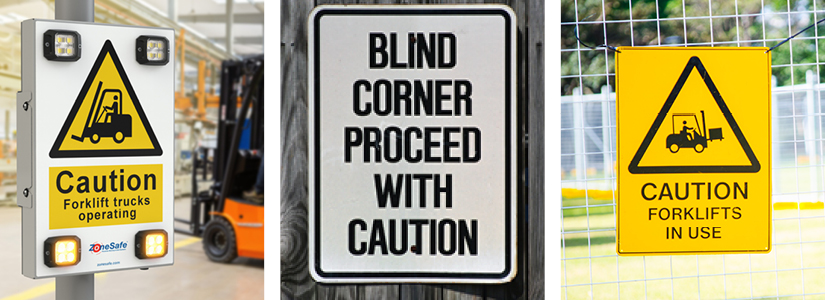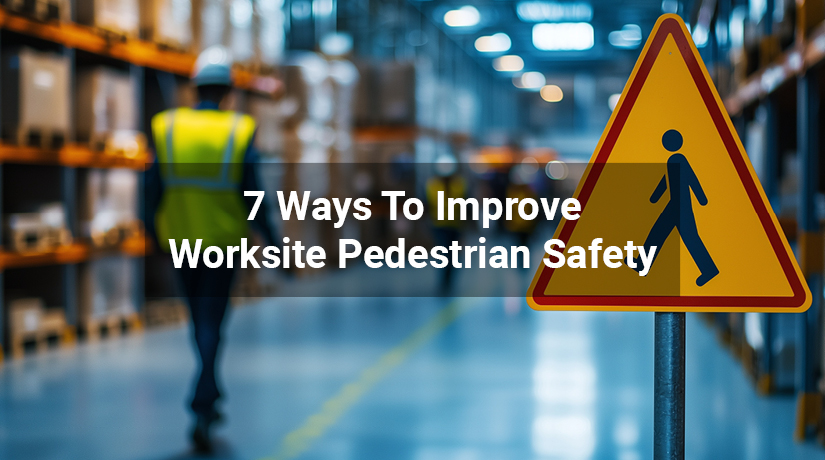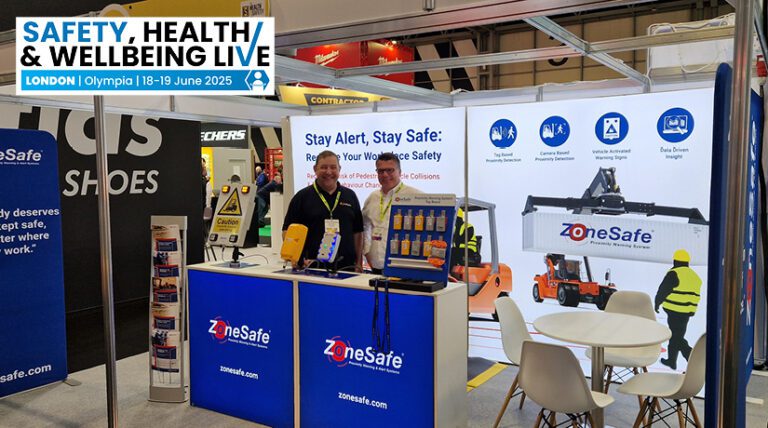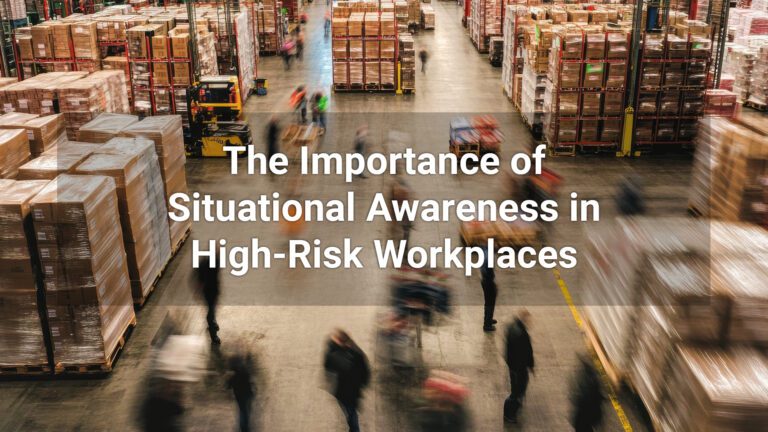Worksite pedestrian safety is just one of many issues that are incredibly important to the safety and success of any business. Safety is paramount. Not only does it ensure people remain fit and healthy, but it can also positively affect each staff member. Employees feel secure and enjoy a safe space, company values, and a positive co-working environment, which encourages respect for everyone. High morale generally means higher engagement, productivity, and attentiveness, which can be vital for identifying and mitigating risks on a worksite.
Worksites are dangerous for many reasons, but one of the biggest fears is workplace pedestrian safety. Whether it’s a forklift in a warehouse, a shovel loader on a recycling site or a reach stacker in a port, both driver and pedestrian need to have their wits about them. Sites operating industrial vehicles and plant machinery are dangerous to pedestrian workers, especially when working in close proximity. Due to their shape, size and the loads each vehicle carries, it’s easy for a driver not to see a pedestrian worker while operating their vehicle. With limited visibility, each vehicle can have many blind spots. Then there’s the environment the vehicles work in. Often noisy, dusty, dirty or dimly lit, each worksite can be littered with blind corners, concealed entrances or obstructions like racking or stacks of product, further increasing the risk of accidents and collisions.
Selon le The HSE’s latest report, being struck by a moving vehicle has the second highest fatality rate (after falls from height). Still, more worryingly, statistics show that being struck by a moving vehicle is on the rise. Twenty-five workers were killed in 23/24, an increase of 25% over the previous year’s report. With a new report scheduled to be released in the next couple of months, let’s hope the fatality rate hasn’t increased again, and that worksite pedestrian safety has improved.
How Do You Improve Worksite Pedestrian Safety?
1. Segregation
Installing physical safety barriers to create safe walkways is usually the safest and easiest way to protect pedestrian workers from moving machinery. However, sometimes installing barrières de sécurité doesn’t always work due to existing site layout or lack of space. Safety barrier systems work exceptionally well when they’ve been incorporated into the design of a brand-new warehouse, and all areas have been pre-defined.
Line markings are a form of segregation to consider and are often used with safety barriers to create safe walkways. However, without a physical barrier, worksite pedestrian safety relies on pedestrians and drivers never crossing the walkway lines. Although pedestrians and vehicles have clearly defined routes, a warehouse can still be considered dangerous to pedestrian workers without any physical barriers fitted to segregate them from moving vehicles. Line markings can also wear away over time and will need to be repainted.
When you can’t use safety barriers to segregate, what are the other options to create a safe worksite? The answer is to look at safety technology solutions such as proximity warning systems or AI Cameras. ZoneSafe est un système d'avertissement et d'alerte de proximité that uses safety technology to keep your workforce safe. The system uses RFID to create an invisible 360-degree safety barrier or detection zone around each vehicle, automatically warning both the driver and the pedestrian worker when they get too close to each other. ZoneSafe will also detect pedestrian workers when they can’t be seen, like behind objects such as racking, walls and stacks of product. Vehicle and pedestrian detection are critical for worksite safety, and creating warning alerts for pedestrian workers (tag vibration) and vehicle drivers (in-cab control unit warnings) significantly increases their situational awareness, thus improving safety and helping to reduce accident risk.
Other technology solutions, such as AI camera systems or warning light solutions, should also be considered. Camera systems are great for detecting pedestrian workers and a great alternative to proximity warning systems, but unfortunately, they can’t detect pedestrians from behind racks, walls or product stacks. Multiple cameras may also have to be purchased in order to be able to see in every direction or 360 degrees around the vehicle, which can be costly. Pedestrian detection warnings alert the driver to the pedestrian’s location, but they don’t warn pedestrian workers of the danger of approaching vehicles. Sometimes it can be difficult for cameras to perform in dusty, dirty and dimly lit locations. Camera lenses must be kept clean at all times in order to detect pedestrian workers correctly every time.
Warning light solutions, often known as halo systems (due to the shape of the light beam around the vehicle), are cheaper alternatives to proximity warning and camera solutions. They project a clear, well-defined line on the floor around the vehicle, marking a safe distance that pedestrian workers should avoid. This helps prevent people from standing too close, reducing the risk of injuries caused by sudden turns or rear-end swings of the vehicle. Light solutions work really well in noisy indoor environments. Often they can’t be seen so easily outside, especially when it’s sunny. And it’s up to the pedestrian worker to be looking the right way and see the light marking on the floor.

2. Warning Signs
A simple, easy, and cost-effective solution, signs can be strategically placed around the worksite to warn of the danger of vehicles working close by. However, a basic sign relies on anyone entering the area to read the sign. Often, when many signs are fitted in a specific place, over-familiarity or repeated exposure means the awareness of vital safety signs often diminishes. This is called sign blindness. To help counter this and improve worksite pedestrian safety, ZoneSafe has developed the Active Warning Sign range. Intelligent signage now detects moving vehicles and flashes whenever a vehicle is present. When a vehicle moves away, the sign stops flashing because there is no longer any immediate danger to pedestrian workers. ZoneSafe’s Active Warning Sign range is also used to warn the general public on worksites where it’s not just the workers interacting with moving vehicles. Worksite pedestrian safety can be just as crucial in marinas and ports, or areas where the general public also has access.
3. Traffic Control and Speed Management
Depending on your site layout, you can set up one-way systems, safe crossing points, and traffic-calming measures like chicanes, speed bumps, or reduced-speed zones to increase worksite pedestrian safety. Depending on the type of vehicle, ZoneSafe can detect a vehicle and slow it down in specific areas or detect a vehicle and open, close, or automatically lock a pedestrian barrier. Floor graphics, such as zebra crossings or warning signs, can be automatically projected onto the floor upon detection of vehicles entering or leaving specific detection zones. It’s worth noting, however, that floor-projected signs work best inside rather than outside.
4. Vehicle Training and Refresher Courses
Forklifts, shovel loaders, or tous industrial vehicle can be incredibly dangerous if operated incorrectly. Proper training and refresher courses are crucial for workplace pedestrian safety, compliance, and efficient operations. They ensure operators maintain good driving habits and reduce the risk of accidents.
5. Vehicle maintenance
Regular maintenance of all worksite vehicles is also crucial for workplace pedestrian safety. It helps identify minor issues before they escalate into something more serious. Regular checks for brakes, tyres, lights, and safety systems help ensure your vehicle is safe to drive.
6. Turn Off Mobile Phones
Using a mobile phone at work can be dangerous to both drivers and pedestrian workers. Getting distracted for just a few seconds is enough time to cause or be involved in an accident. Introduce mobile phone-free areas where moving vehicles operate. Or be extremely vigilant and make sure you are nowhere near any vehicle movement when using your phone. Having no distractions and concentrating on the task at hand helps to improve worksite pedestrian safety.
7. Adequate Lighting and Visibility
Always ensure there is sufficient lighting in areas where pedestrians and vehicles work together. Make sure everyone on-site wears high-visibility clothing at all times to make them easier to spot.
For more information about ZoneSafe and how we can increase worksite pedestrian safety on your site, contact us today on 01202 868000, email sales@zonesafe.com or click here for the contact us form.





